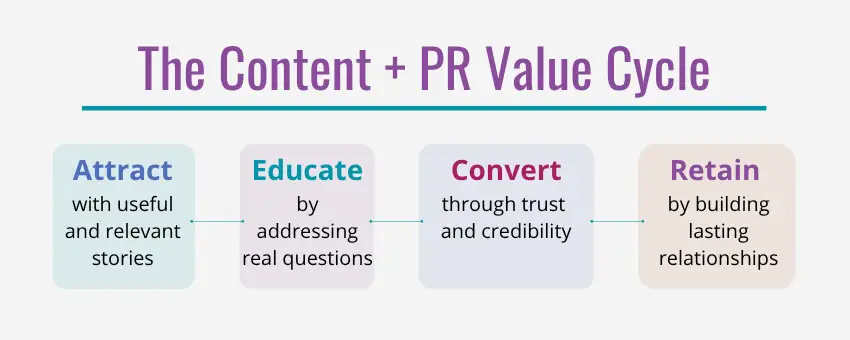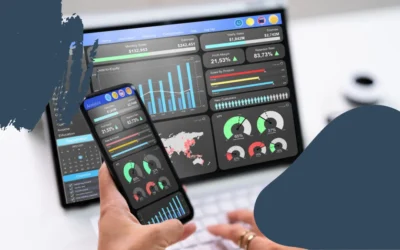Content marketing has gained significant relevance in recent years due to the multiple benefits it offers brands: it improves visibility, attracts new clients, strengthens relationships with existing ones, and helps build reputation. This evolution reflects today’s reality—where standout companies are not those that communicate excessively, but those that educate, inspire, and build trust through purposeful, valuable content.
When this approach integrates with Optimized Public Relations (RPO), the result is a powerful synergy that multiplies visibility, credibility, and conversion. This is achieved through a Unified Media Ecosystem —earned, owned, shared, and paid— which allows brands to tell stories that are discovered with authority in both search engines and AI-powered conversation spaces.
What is a content marketing strategy?
By definition, content marketing is a marketing approach focused on creating and distributing valuable, relevant, and consistent content to attract and retain a clearly defined audience, ultimately driving profitable action (Content Marketing Institute).
In the realm of public relations, a well-designed content marketing strategy must consider the stages of the buying cycle and the different decision-maker profiles within an organization, making it a key tool to increase brand visibility, drive website traffic, and generate business opportunities.
How to integrate a content marketing strategy into a PR campaign
A content marketing strategy integrated with PR aligns all communication channels under one shared goal: to attract, educate, convert, and retain audiences through valuable content. Here’s how each media type within the Unified Media Ecosystem (UME) contributes:
- Owned media: the core of your brand narrative. Blogs, newsletters, and social channels act as authority spaces that share educational content, positioning the brand and retaining audiences.
- Earned media: amplifies your brand voice through editorial coverage and media collaborations that validate credibility.
- Shared media: fosters conversation and community through posts, videos, and infographics that drive engagement and advocacy.
- Paid media: extends reach with precision and directs qualified traffic toward your organic content, boosting the overall return on your strategy.
When these four pillars work together under the Optimized Public Relations model, every story achieves greater discoverability, digital authority, and measurable value.
Did You Know?
72% of marketers say that content is an effective strategy for lead generation. (Contently)
The role of content marketing in an earned media strategy
When content marketing is integrated with public relations, different channels and tactics can be leveraged to maximize brand exposure through a coherent narrative:
- Traditional media: Allow brands to communicate key messages to target audiences, strengthening image and credibility.
- Online media / social platforms: Enhance a brand’s online presence by improving search visibility and attracting website traffic through relevant content and backlinks.
Benefits of a content marketing strategy in public relations
- Builds trust and credibility: Valuable content strengthens brand image and positions it as an industry reference.
- Increases visibility in digital and traditional media: Enhances brand exposure to new audiences and facilitates relationships with media, opinion leaders, and journalists.
- Improves organic search rankings (SEO): Optimized content with keywords and backlinks boosts digital authority.
- Creates an authentic brand story: Through storytelling, a brand can connect emotionally with its audience.
- Encourages interaction and engagement: Inspires conversations and fosters loyalty among current customers.
- Generates consistent traffic with evergreen content: Useful, relevant information that continues to attract visitors over time.
In public relations, these benefits translate into building trust, thought leadership, and direct support for marketing and sales initiatives.
Keys to developing an effective content marketing strategy
A successful strategy begins with deeply understanding your audience: What are their interests? What pain points are they trying to solve? On which channels do they consume information?
In addition, it’s essential to consider the following elements to align content with the customer buying journey and provide useful resources for each stage of the decision process — from consideration to evaluation:
- Define clear objectives: From enhancing brand reputation to generating leads and boosting conversions.
- Select the right channels and formats: Identify the most relevant platforms for content distribution and choose the formats that best meet decision-makers’ information needs (articles, videos, infographics, podcasts, and more).
- Create an editorial calendar: Plan content production and distribution in a structured way—remember that consistency and quality matter more than quantity.
- Measure and optimize results: Use actionable metrics to evaluate content performance and make strategic adjustments.
What type of content has the greatest impact in a PR strategy?
The most effective content is that which answers questions, educates, entertains, or inspires the audience. It’s not just about talking about your brand—it’s about delivering real value to your future customers.
- Written content: Articles, press releases, media collaborations, case studies, or expert interviews tend to be most effective for building authority.
- Visual content: Infographics, illustrations, and social media carousels help increase reach and engagement.
- Audiovisual content: Videos, podcasts, and live webinars are ideal for entertaining and creating an emotional connection with target audiences.
The power of a well-executed content marketing strategy
In today’s digital landscape, content marketing and public relations form a powerful combination for brands that aim to grow, differentiate themselves, and build authentic connections with their audiences.
This integration goes beyond theory—it delivers tangible results. Below are examples of content marketing in action within a PR strategy:
Brand positioning in financial technology
A global identity verification company implemented a content marketing and PR strategy focused on brand positioning in Mexico and Latin America. Through specialized content, interviews with key media, and strategic editorial coverage, the company strengthened its digital authority and positioned itself as a leader in regulatory compliance and fraud prevention.
As a result, it achieved over 100 media publications in business and technology outlets, along with sustained growth in organic mentions and referral traffic.A global identity verification company implemented a content marketing and PR strategy focused on brand positioning in Mexico and Latin America.
- Action: development of specialized articles, interviews with key media, and consistent editorial coverage.
- Result: over 100 publications in business and technology media, sustained growth in organic mentions, and increased referral traffic.
- Insight: expert content, strategically distributed, becomes measurable reputation.
Integrated communication strategy in manufacturing
A leading digital printing solutions company used content marketing and PR to strengthen its presence in Mexico and Latin America.
Action: content placement in specialized media, participation in industry events, and thematic campaigns.
Result: over 180 publications, a notable increase in digital engagement, and higher brand recognition.
Insight: consistent, value-driven storytelling amplifies visibility, reputation, and demand.
Beyond a trend, this formula attracts, educates, and converts clients across multiple industries. In the B2B environment, it represents a strategic investment that drives measurable, sustainable results aligned with business goals in a highly competitive market.
Ready to turn your content marketing into real results with PR?
FAQs
1. What is the goal of content marketing?
The goal of content marketing is to attract, educate, and retain audiences through useful, relevant information that provides real value. Instead of focusing on direct selling, this strategy builds trust and credibility by showcasing a brand’s expertise and addressing audience needs.
When integrated with Optimized Public Relations (RPO), content marketing becomes a key tool to increase organic visibility, strengthen reputation, and accelerate conversion—connecting authentic stories with the right channels and audiences within a Unified Media Ecosystem.
2. How is content marketing applied?
Content marketing is applied through strategy, consistency, and purpose. It starts by understanding your audience—what they search for, what problems they need to solve, and how they consume information. From there, a narrative is designed to educate, connect, and position the brand throughout the buying journey. Implementation requires creating valuable content in multiple formats—articles, videos, infographics, or podcasts—and distributing it intelligently across owned, earned, shared, and paid media.
3. What is needed to do effective content marketing?
Successful content marketing requires a clear strategy, deep audience understanding, and consistency. First, define concrete goals—from improving visibility to strengthening reputation or generating business opportunities. Then, develop a structured editorial plan, create high-quality content optimized for search engines, and distribute it smartly within the Unified Media Ecosystem (earned, owned, shared, and paid). Analytics tools are also essential to measure results and optimize every action.






